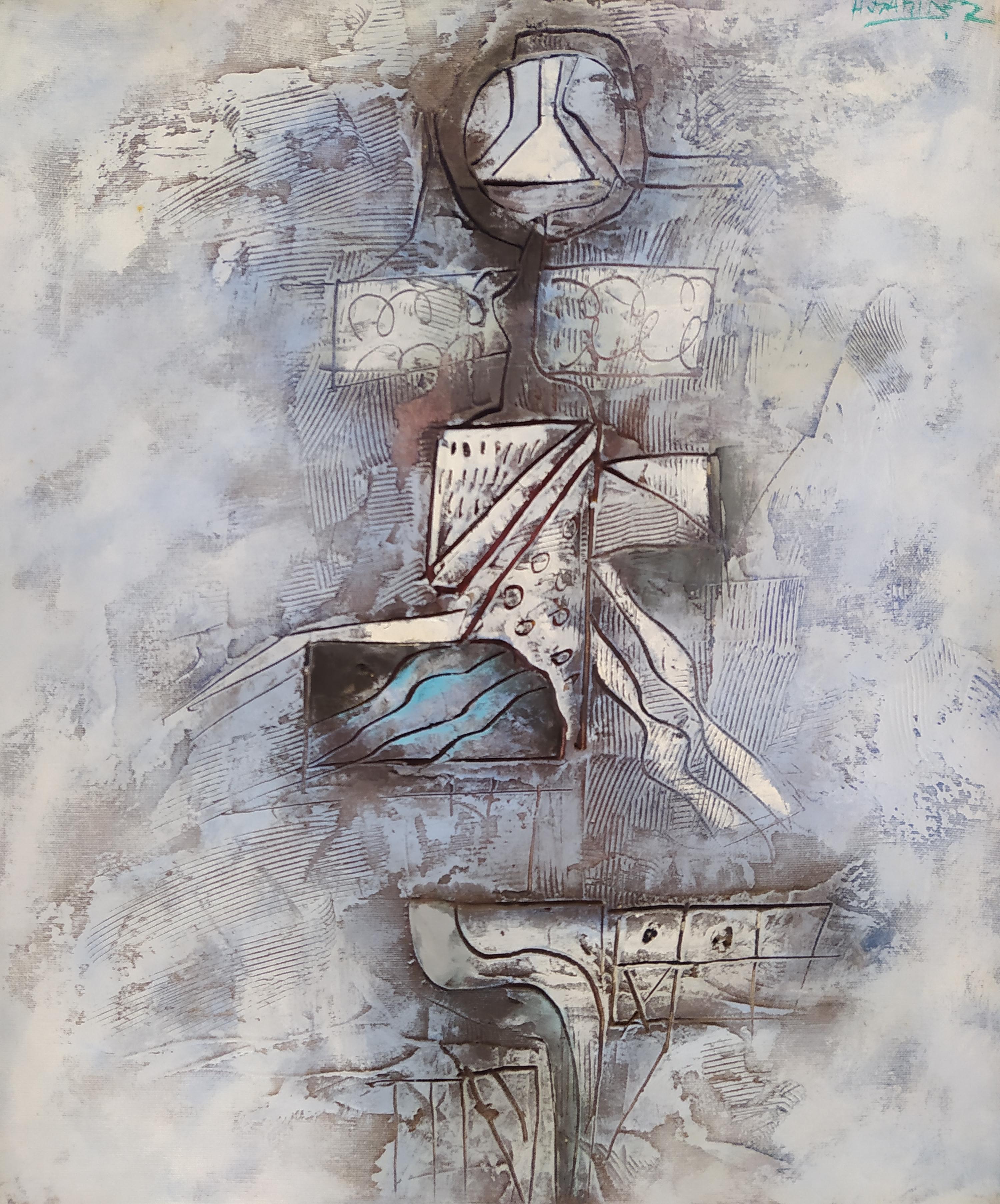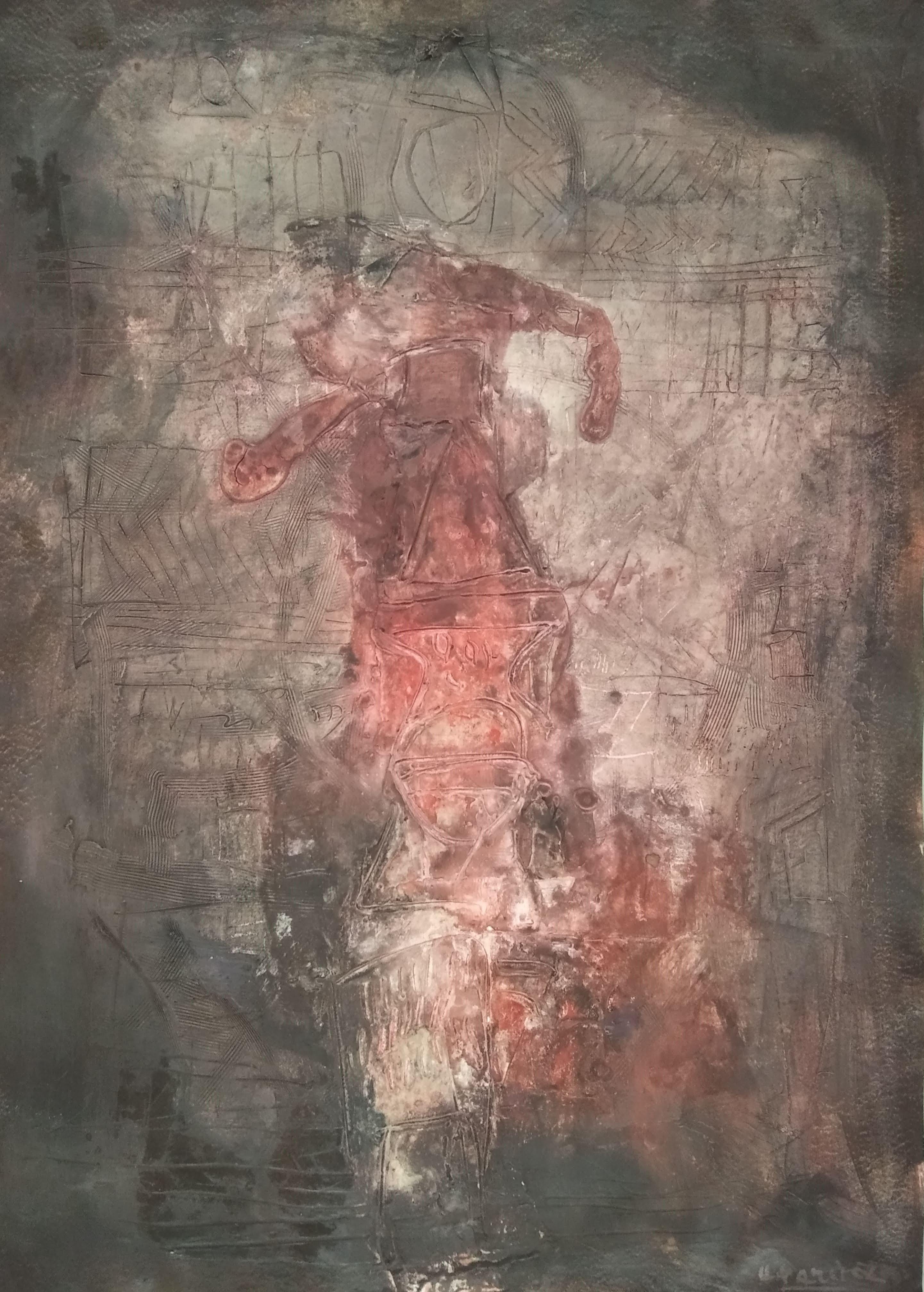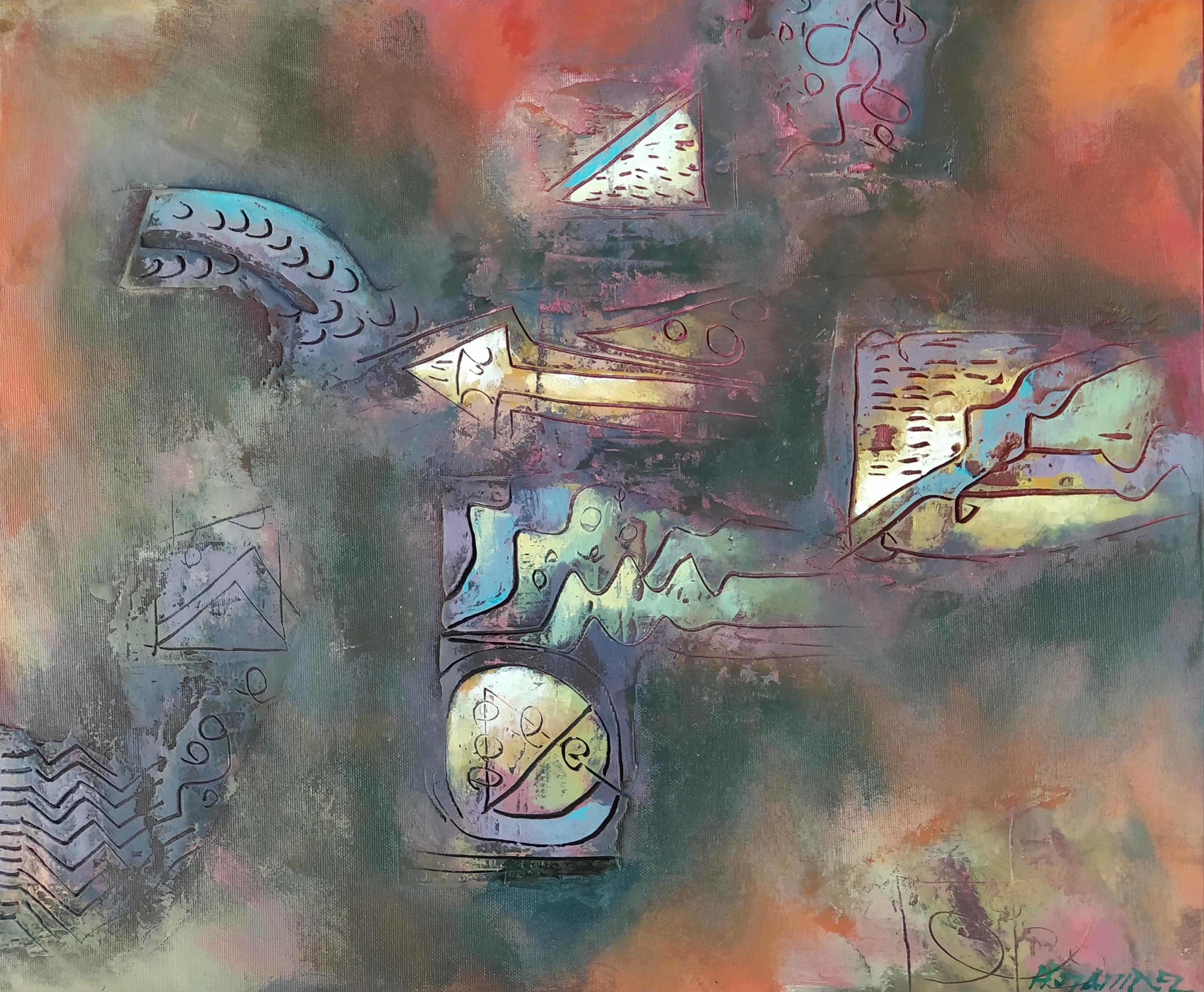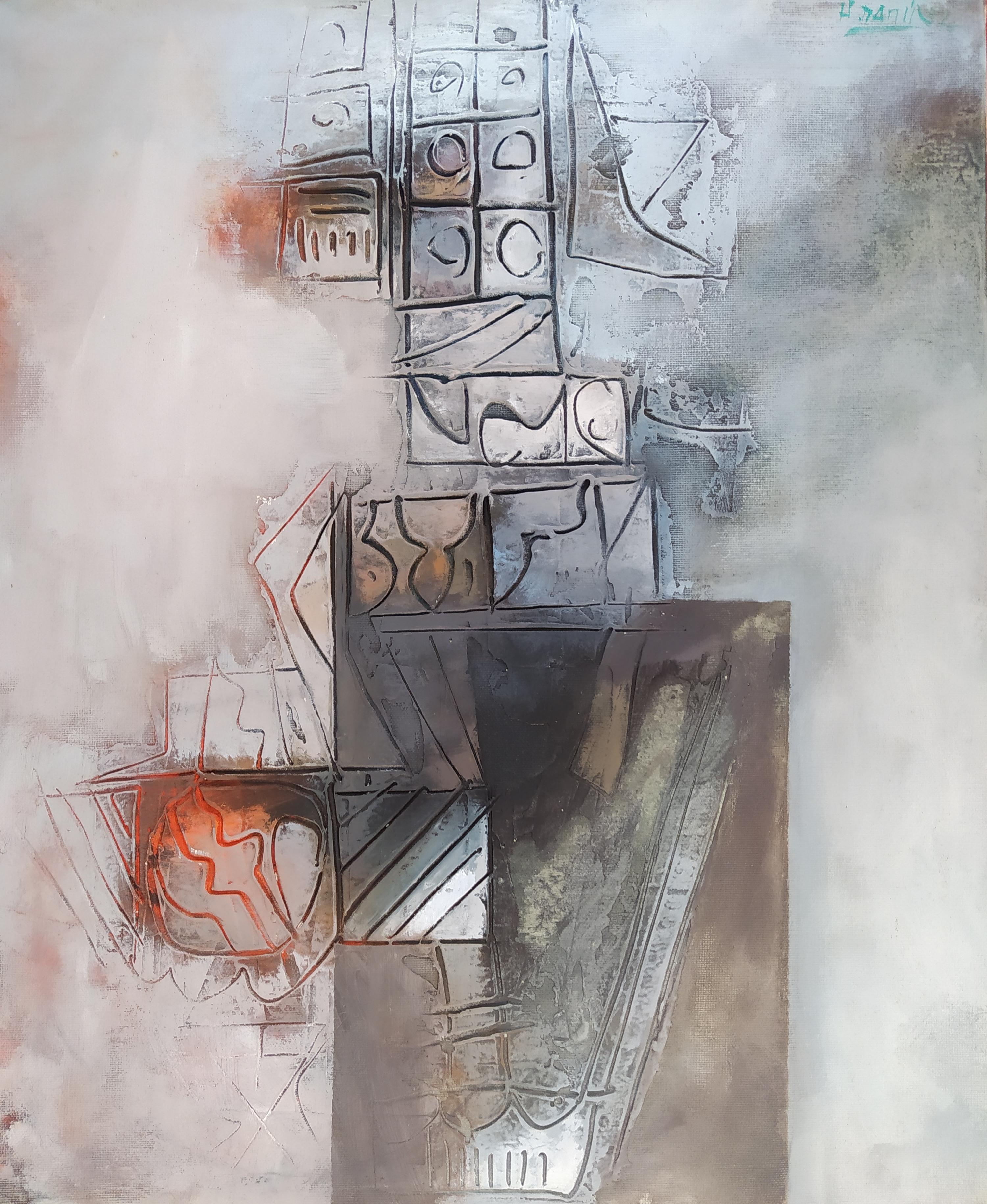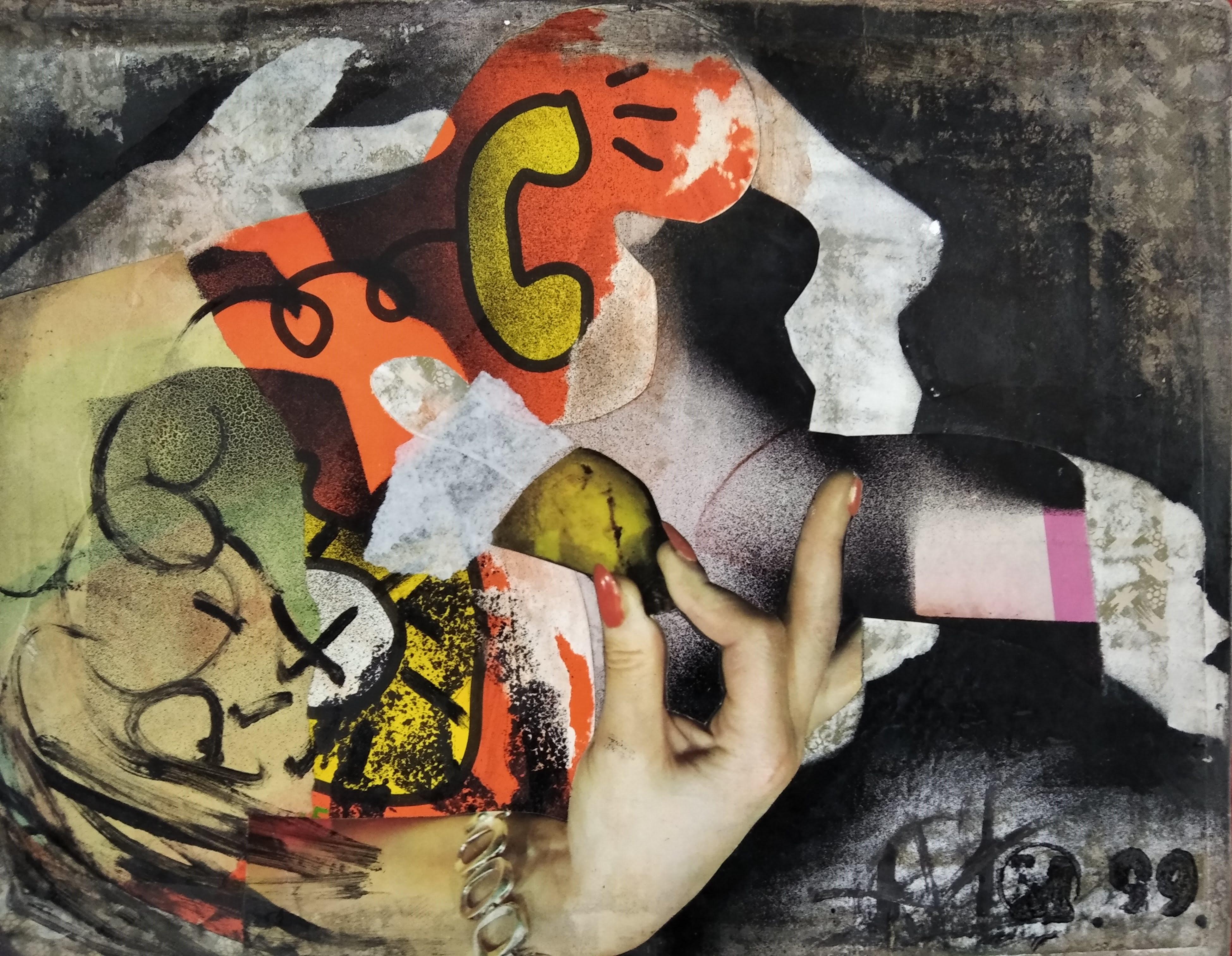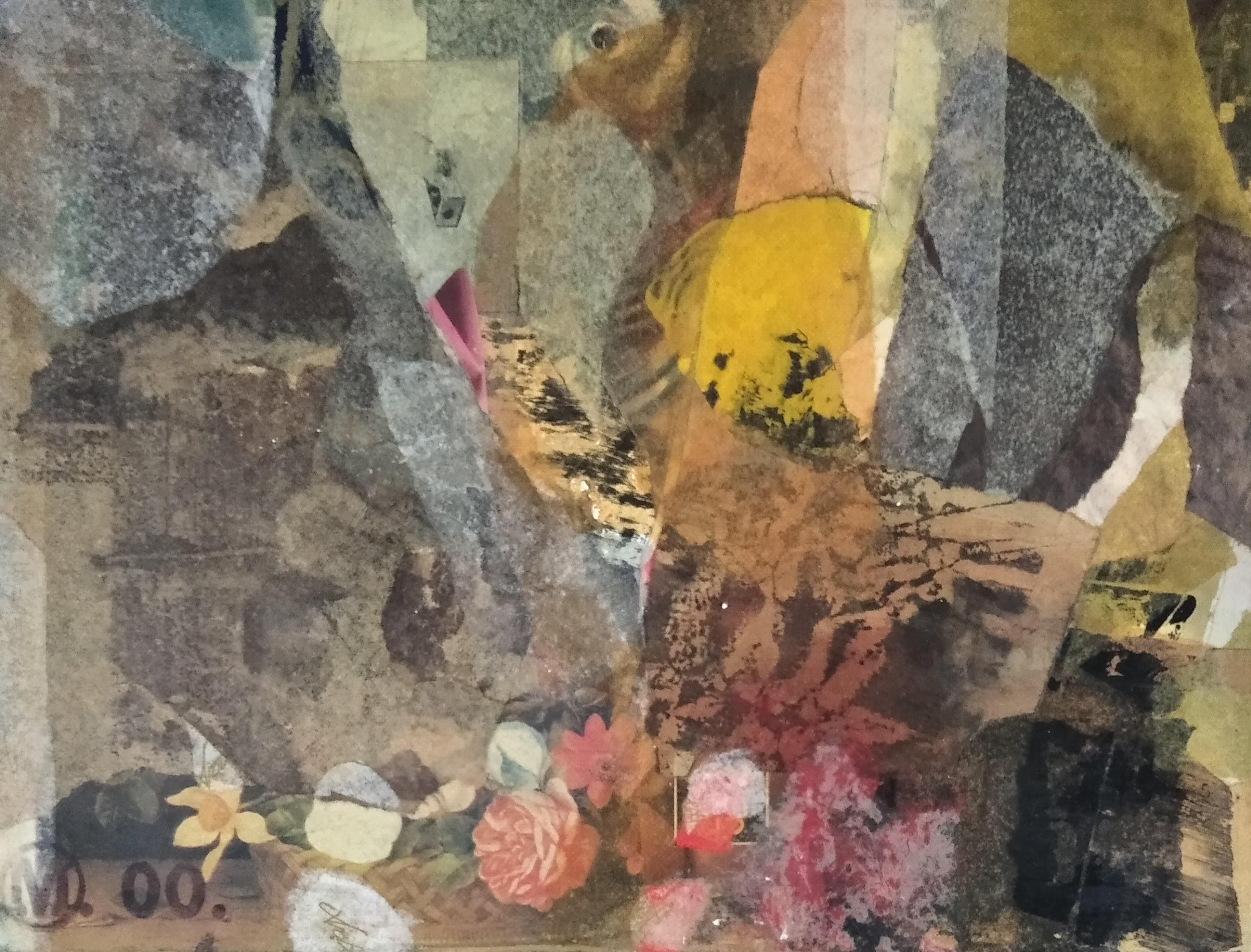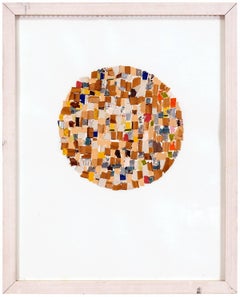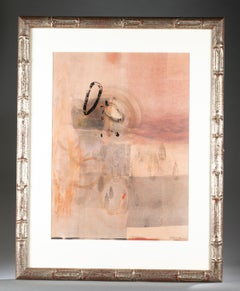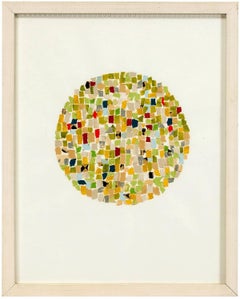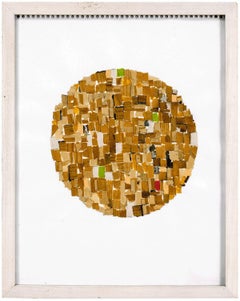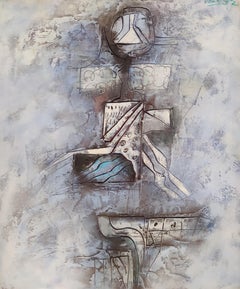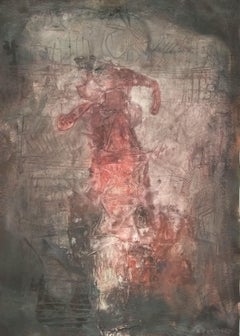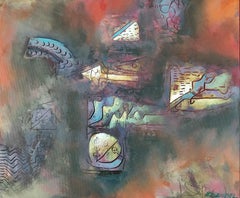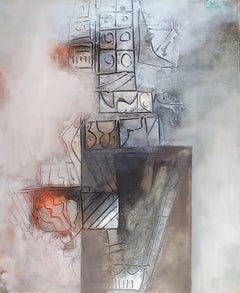Items Similar to Feliciano Bejar REHILETE #2 Mixed Media Avant Garde Artwork
Want more images or videos?
Request additional images or videos from the seller
1 of 5
Feliciano BéjarFeliciano Bejar REHILETE #2 Mixed Media Avant Garde Artwork1980
1980
$2,900
£2,217.39
€2,540.04
CA$4,090.17
A$4,451.68
CHF 2,378.82
MX$53,759.28
NOK 29,895.91
SEK 27,806.68
DKK 18,975.27
About the Item
Genre: Latin American
Subject: Abstract
Medium: Mixed Media, Collage
Country: Mexico
Dimensions w/Frame: 16.75 x 16.5
Feliciano Béjar Ruíz (1920 – February 1, 2007) was a Mexican artist and artisan, best known for a style of sculpture called “magiscopios” which involved various materials along with crystals and/or lenses to play with light or create distorted visions. He was born in rural central Mexico and was completely self-taught as an artist. He was creative as a young child, drawing and creating his first sculpture like pieces from papier-mâché. His art career began in New York, where he had travelled and lived for a time in Hell’s Kitchen. His drawing the attention of Arthur Ewart and Frances Coleman, with the latter helping him have his first exhibition and whose husband helped sponsor his time in Europe. In his later life, Béjar withdrew from the art world for about sixteen years, disillusioned with it and retreating to his ranch in the State of Mexico. He returned in 1998, with a retrospective of his work in Mexico City and continued to show his work until shortly before his death.
He worked as an assistant to a carpenter, sweeping out the shop in exchange for wood scraps. He used these to create toys and even large imaginary cities.
When he was fifteen, he began to teach himself art using various scrap materials. At this time muralist José Clemente Orozco was in his town to paint scenes of the Mexican Revolution on the town library. Bejar brought him some drawings to show, he did not want to see them. Later in life he stated that he did not think well of the muralists and considered them false and frauds. He said that their work was supposedly for the people but they could not be understood without interpretation and the main ones (Rivera, Siqueiros and Orozco) shut out other artists.
When he got to New York in the 1940s, he was disappointed and thought it ugly. He wanted to return but had no money so he had to work menial jobs and live in Hell’s Kitchen. During this time in New York, he was put in touch with English painter Arthur Ewart who encouraged him to get back to art, particularly painting. He also met socialite Frances Colman, while copying paintings at the Metropolitan Museum of Art, who helped him get started selling his work. In 1947, he returned to Mexico. Coleman helped him have an exhibition in New York and in 1949, Béjar traveled to Paris and bicycled through Europe to study the art in the museums there, sponsored by UNESCO and Coleman’s husband. He returned again to Mexico in 1950.
He returned again to Europe in 1956, where he painted and worked as a movie extra and radio announcer.
In 1960, Béjar met Englishman and historian Martin Foley, who had come to Mexico to study. They remained friends for over forty years and lived together at Béjar’s ranch until his death, with Foley writing Béjar’s biography. Foley never entered Béjar’s studio because he was concerned with stepping on something.
However, he considered himself an artisan first, valuing his skills as a carpenter, metalworker and bricklayer, rebuilding the house and gardens himself.
In the early 1990s, he withdrew from his art career, disillusioned by the art work, and in 1993, he was confined to a mental facility by his family involuntarily. Although he left the hospital some time later, a number of his family members still considered him crazy.
Béjar was considered to be an environmentalist. One reason for this was that in his early career, he had a sign in front of his house offering to take used materials for his art, and received much. It made him reflect on how much is wasted. His interest in ecology was also spurred by his time in Mexico City, when he lived for a while near Paseo de la Reforma, seeing how its trees and old mansions were deteriorating.
Béjar died in Mexico City on February 1, 2007, of heart failure while in a hospital for tests. He was 86. He left behind about 100 unfinished pieces because of his system of working. He was buried at his ranch in the State of Mexico. Much of his finished and unfinished work is now in the hands of Martin Foley.
Although Béjar did painting, handcrafts and even trades, he is best known for his sculpture, especially a class of sculpture called “magiscopios.” These were created with metal, glass, crystal, plastic and resins, and feature crystals and lenses that distort the onlookers view. He created the first of these with waste metal and other scraps. After he created his first one, he invited Paco de al Maza, Justino Fernández, Salvador Novo and others for dinner. After seeing the work they thought about names with Jorge Hernández Campos coming up with “magiscopio.” When Béjar exhibited these magiscopios at the Palacio de Bellas Artes in 1966, he signified a break for a generation of avant garde sculptors, and from traditional Mexican sculpture. The magiscopios brought Béjar fame and many of them were copied and reproduced; however, their popularity meant that no one wanted to see his paintings, which bothered him.The popularity also meant that he stopped making them from scraps, especially when he was hired as an artist-in-residence for Carburandum in the US, their first from Latin America. He signed a contract for five years which allowed him to work at their factory and work with larger pieces of materials.
Béjar’s art career began as a painter, and began in New York where he had his first individual exhibition of 18 paintings at the Ward Eggleston Gallery in 1948.However, this success did not open doors for him in Mexico when he returned, not being able to do so until he had the support of the Instituto Mexicano Norteamericano. This show brought his work to the favorable attention of Mexican art critics. However, over his lifetime he had over 150 individual exhibitions and his work appeared in about 100 collectives ones, both in Mexico and abroad. He had a sixteen-year break in exhibiting his work until 1998,when the Instituto Nacional de Bellas Artes sponsored a retrospective. They wanted to have it at the Palacio de Bellas Artes or the Museo de Arte Moderno, but Béjar refused, stating that these avenues were too closed to new artists, so instead it was held at the Museo de Arte Carrillo Gil.
He received a number of awards but stopped accepting when the Bank of Mexico asked him to purchase the medal he was awarded because they lacked resources. He also became disenchanted with the attention given to him by politicians including Mexican presidents He was a member of the Salón de la Plástica Mexicana
Béjar was a prolific creator and while much of his production has been acquired for permanent collection, much is in the possession of his longtime friend Martin Foley. At least 75 of his works are part of major museum collections in Brazil, the United States, Great Britain and Israel.
Since his death in 2007, there have been events to pay homage and exhibitions of his work, including a 2010 homage and conference at the Liberator Miguel Hidalgo y Costilla Cultural Center in his hometown in Michoacán and a major exhibition of his work at the Museum of Light in Mexico City in 2013. There have also been efforts to create a formal museum in Béjar’s memory. His former home in Michoacán has been opened to the public and contains a collections of his paintings, sculptures and handcrafts.
While best known as a sculptor, he was also a painter, artisan and a tradesman, not seeing differences between artist and artisan, instead considering them inseparable. He worked with various techniques such as painting, drawing, engraving and sculpture in wood, ceramic, soldered metal, bronze, stone, stainless steel, crystal and plastic. He defined himself as a creator who did not belong to the artistic elite on Mexico. Although not considered part of the Generación de la Ruptura, his work did open new avenues for artists in Mexico. He was noted for his use of geometry, transparency and light and was contrarian in various aspects. For example, he began to work in terracotta when many artisans were dismissing it in favor of porcelain.
- Creator:Feliciano Béjar (1920, Mexican)
- Creation Year:1980
- Dimensions:Height: 16.75 in (42.55 cm)Width: 16.5 in (41.91 cm)
- Medium:
- Movement & Style:
- Period:
- Condition:
- Gallery Location:Surfside, FL
- Reference Number:1stDibs: LU38211602552
About the Seller
4.9
Platinum Seller
Premium sellers with a 4.7+ rating and 24-hour response times
Established in 1995
1stDibs seller since 2014
1,843 sales on 1stDibs
Typical response time: 1 hour
- ShippingRetrieving quote...Shipping from: Surfside, FL
- Return Policy
More From This Seller
View AllMixed Media Abstract Collage
By Alejandra Icaza
Located in Surfside, FL
Genre: Contemporary
Subject: Abstract
Medium: Mixed Media, Collage
Surface: Paper
Country: Spain
Dimensions: 14" x 11"
Dimensions w/Frame: 15" x 12"
Alejandra Icaza Born in Bilbao, Spain in 1966. Lives and works in Madrid. Icaza studied at Saint Martins College in London (1985) and at The New York Studio School of Drawing, Painting and Sculpture in New York...
Category
Late 20th Century Mixed Media
Materials
Mixed Media
Mixed Media Abstract Modernist Painting Dean Nimmer
By Dean Nimmer
Located in Surfside, FL
Dean Nimmer (American, b. 1935). "Adrift". 2000.
Multi-media on paper. Hand signed, dated in pencil lower right
Image: 21.25" x 29". Framed: 32.5" x 41".
Dean Nimmer has exhibited his art in over 200 solo and group exhibitions across the U.S., Europe, Asia, and Australia since he began his art career in 1970. His artworks are in the collections of the Boston Museum of Fine Arts, DeCordova Art Museum, Smith College Art Museum, Harvard University, Peabody/Essex Museum and many other museums across the U.S. and abroad.
Dean was given the 2010, Distinguished Teaching of Art Award, granted by the 16,000- member College Art Association, the 2011 Distinguished Alumnus Award granted by the University of Wisconsin and honored as the Outstanding Community Teacher of the Year for 2014/15 by the state of Massachusetts. He is the author of the successful book, Art from Intuition, Random House, 2008, that is currently in its 9th printing, and Creating Abstract Art, (North Light Books, 2014).
In 1967 Drummer Dean Nimmer, Jay Borkenhagen, bassist Rick Bieniewski, guitarist Jacques Hutchinson, formed The Baroques, a band that challenged the sonic conventions and industry norms of the time. After signing to Chess Records, a then exclusively black Rhythm and Blues label responsible for likes of Muddy Waters and Howlin...
Category
Early 2000s Contemporary Abstract Paintings
Materials
Mixed Media
Mixed Media Abstract Collage
By Alejandra Icaza
Located in Surfside, FL
Alejandra Icaza Born in Bilbao, Spain in 1966. Lives and works in Madrid. Icaza studied at Saint Martins College in London (1985) and at The New York Studio School of Drawing, Painting and Sculpture in...
Category
20th Century Modern Mixed Media
Materials
Mixed Media
Mixed Media Abstract Collage
By Alejandra Icaza
Located in Surfside, FL
Genre: Contemporary
Subject: Abstract
Medium: Mixed Media, Collage
Surface: Paper
Country: Spain
Dimensions: 14" x 11"
Dimensions w/Frame: 15" x 12"
Alejandra Icaza Born in Bilbao, Spain in 1966. Lives and works in Madrid. Icaza studied at Saint Martins College in London (1985) and at The New York Studio School of Drawing, Painting and Sculpture in New York (1989). She is the recipient of the painting award of Fundación Barceló, Palma de Mallorca. The artist works with repetition of form, color, and shapes. Trees, animals, abstract patterning, floating elements, portraits, bubbles, and plants are elements of her work, in which different planes collide. Alejandra Icaza has had several gallery and museum exhibitions, including at the Blum & Poe and at the Danziger Projects.
Education
1989 The New York Studio School of Drawing, Painting and Sculpture, New York
1988 Maryland Institute College of Art, Maryland 1987 Massana School, Barcelona, Spain
1986 Fellowship with Federic Amat and Andres Nagel, Spain
1985 St. Martin´s School of Art Master degree, London
1984 Camden Centre of Art Bachelor degree, London
Solo Exhibitions
2009 Fortes Vilaça Gallery , São Paulo, Brasil Pelaires gallery, Palma de Mallorca, Spain Ana Serratosa Gallery, Valencia, Spain
2007 Seaweed and Octopus, Edward Tyler Nahem Fine Art, New York
2006 Fortes Vilaça Gallery , São Paulo, Brasil Pillar Parra & Romero Gallery Madrid, Spain
2004 Domus Artium Salamanca, Contemporary Art Center, Salamanca, Spain 2003 Eclipse, Pedro Cera Gallery, Lisbon, Portugal
2002 Fortes Vilaça Gallery, São Paulo, Brasil Marta Cervera Gallery...
Category
Late 20th Century Contemporary Mixed Media
Materials
Mixed Media
Cuban Art Abstract Oil Painting Latin American Mixed Media Ramon Carulla
By Ramon Carulla
Located in Surfside, FL
Ramon Antonio Carulla (Cuban, born 1936).
Artist signature to lower right. Label verso. Retains original JOY MOOS GALLERY label.
Dimensions: 38.5 X 28 inches. Paper is 28 X 19.5 inches.
This painting is a mixed media with oil paint, on paper
It is hand signed recto and signed and titled verso.
An abstract naive, folk art, work depicting a male figure with geometric forms.
Ramon Carulla, born in Havana, Cuba in 1936 moved to the United States in 1967. He has exhibited widely throughout the United States, Latin America and Europe. He has participated in personal and group exhibitions in Canada, Venezuela, Mexico and Spain and throughout the USA.
Select Gallery Exhibitions:
Lowe Art Museum (Coral Gables, Florida),
The Museum of Fine Arts (Montreal, Canada),
The International Monetary Fund (Washington, D.C.)
The Art Expo (New York City).
Select Awards:
First Prize at the VI Graphic Biennial of Latin America (1983; San Juan, Puerto Rico),
the Silvia Daro Dawidowicz Award for Painting (1980; Metropolitan Museum)
the Samuel Golan Award (1982, Fine Art Auction Exhibition; CH 2, Miami, Florida).
the Cintas Fellowship (Institute of International Education; United Nations, New York)
SELECTED INDIVIDUAL EXHIBITIONS
2005 Sonnet Gallery (Sarasota, Florida)
2000 Ramon Carulla: People and Places - Corbino Galleries,
1998 The Dreamers - Cuban Collection Fine Art (Coral Gables, Florida)
1997 The Immigrant Series – Metro-Dade Cultural Resource Center (Miami, Florida)
1996-96 Ramon Carulla: Works on Paper – PJorn (Hamburg, Germany)
1994 Ramon Carulla: New Paintings, Plates & Boxes – The Barbara Scott Gallery
Rostros para recordar – Galería Traz (Mexico City, Mexico)
1993 Ramon Carulla, Exhibición Personal – Contemporary Art Museum (Panama)
1992 Ramon Carulla: Recent Work - The Barbara Scott Gallery (Bay Harbor, Florida)
1991 Cabinet Room – The Capitol (Tallahassee, Florida)
1988 Sofa & Hostage Series – Jay Moos Gallery
1987 20 Years After – Bacardi Art Gallery (Miami, Florida)
1985 Malcom Brown Gallery – (Cleveland, Ohio)
Mask Series – Forma Galley (Miami, Florida)
Masks, Hats, Other Headgear: A Retrospective - Schweyer-Gallardo Gallery
1983 Recent Works – VI Graphic Biennial (San Juan, Puerto Rico)
1980 Life Boundaries Series – Virginia Miller Gallery (Coral Gables, Florida)
1975 Atelier J. Lukacs (Montreal, Canada)
1967 Bacardi Art Gallery (Miami, Florida)
Ramón Antonio Carulla (born December 7, 1936 in Havana, Cuba) is a Cuban art...
Category
1970s Modern Figurative Paintings
Materials
Paper, Oil
Cuban Artist Emilio Martinez Untitled 1
By Emilio Adan Martinez
Located in Surfside, FL
Emilio Adan Martinez was born in Cienfuegos, Cuba, in 1954. In 1961 at the age of six he immigrated to Miami with his family. He earned his BFA from Florida International University ...
Category
21st Century and Contemporary Contemporary Abstract Paintings
Materials
Oil
You May Also Like
Untitled
Located in Barcelona, BARCELONA
The painting is being offered with a work and authenticity certificate
Category
1990s Abstract Mixed Media
Materials
Canvas
Untitled
Located in Barcelona, BARCELONA
The painting is being offered with a work and authenticity certificate
Category
1990s Abstract Mixed Media
Materials
Paper
Untitled
Located in Barcelona, BARCELONA
The painting is being offered with a work and authenticity certificate
Category
1990s Abstract Mixed Media
Materials
Canvas
Untitled
Located in Barcelona, BARCELONA
The painting is being offered with a work and authenticity certificate
Category
1990s Abstract Mixed Media
Materials
Canvas
Untitled
Located in Barcelona, BARCELONA
The painting is being offered with a work and authenticity certificate
Category
1990s Abstract Mixed Media
Materials
Mixed Media
Bodegón II
Located in Barcelona, BARCELONA
the painting is being offered with a work and authenticity certificate
Category
Early 2000s Abstract Mixed Media
Materials
Mixed Media
